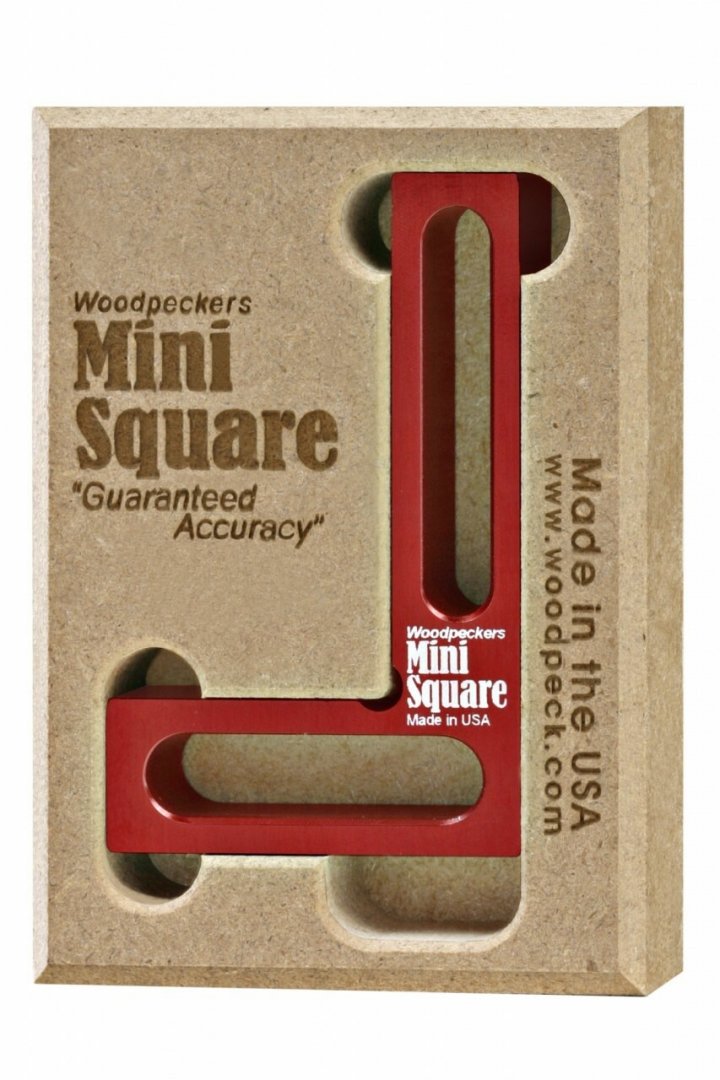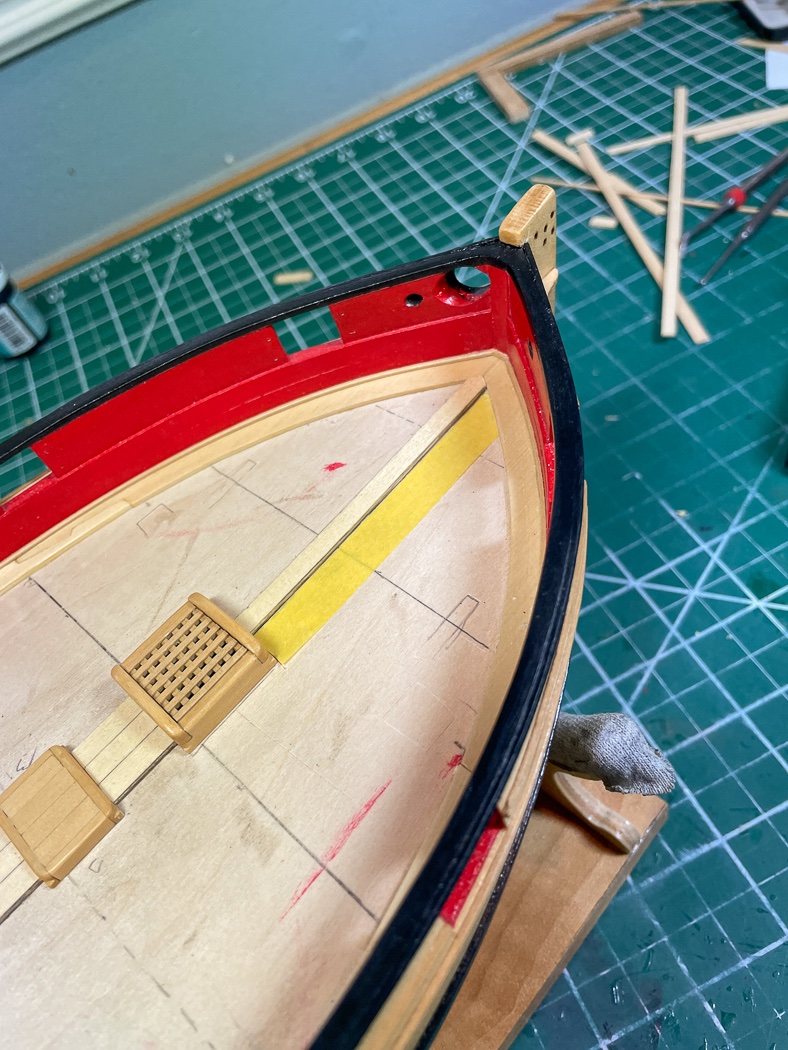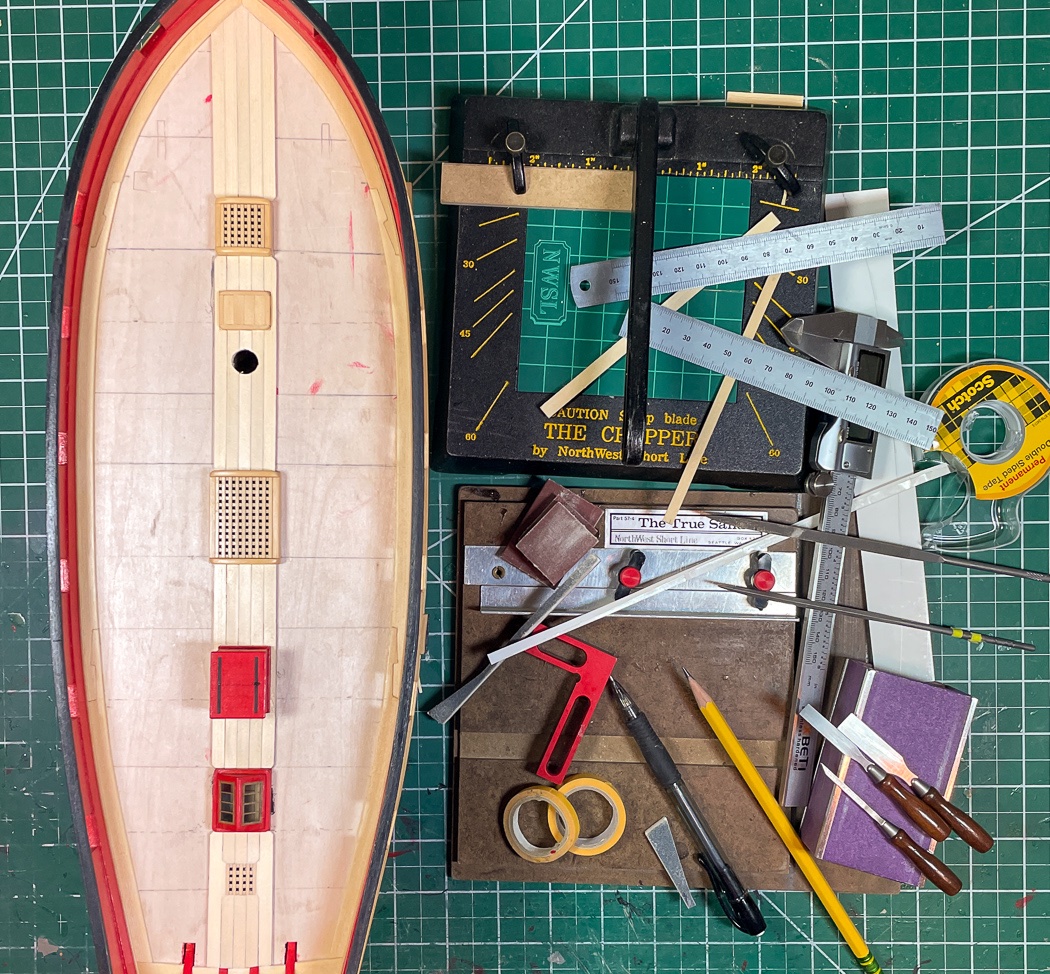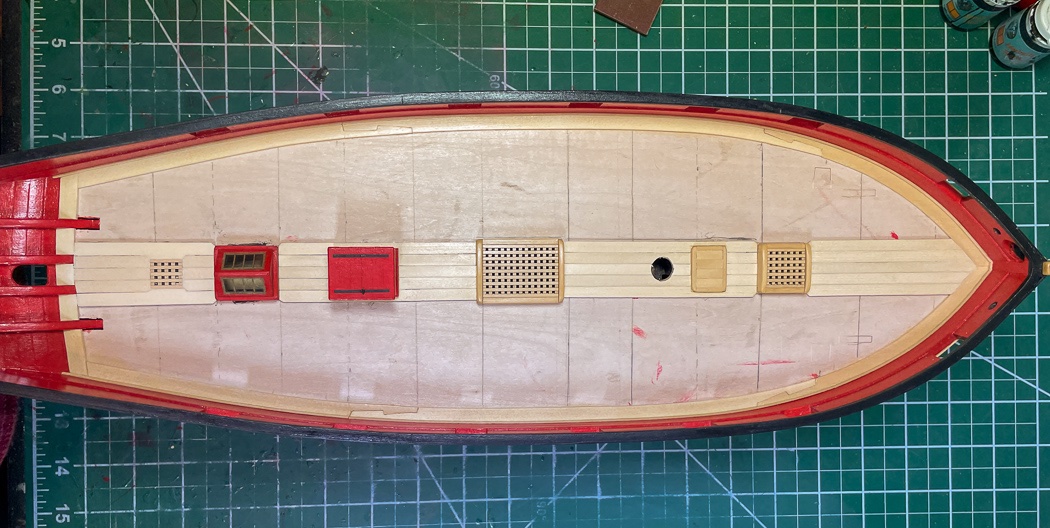-
Posts
4,115 -
Joined
-
Last visited
Content Type
Profiles
Forums
Gallery
Events
Everything posted by glbarlow
-
The truth is breaching ropes are probably enough for those tiny cannon. Especially after the ship is rigged. But is enough good enough. I only did breaching ropes on my Nelson, but that was because I was ready to move on to Cheerful. I will fully rig Flirt when I get there, as very painful to my fingers and eyes that will be. 🤣😂. Only you will notice....😳
-

Reducing mast circumference without a lathe
glbarlow replied to Charlie pal's topic in Masting, rigging and sails
I don’t know about the finger plane part, but I get the taper my taking measurements at various points from the plans then frequently check it against the wood with my digital caliper as I turn it with a drill or lathe using various grits of sandpaper. -
https://www.ustoolandfastener.com/woodpeckers-mini-square-minisquare/?utm_term=&utm_campaign=ECI+- I have three of these and two mini triangles they work great for keeping things square. Sorry for the huge photo and crazy long link. +Google+Shopping+-+All+Products+(non-mobile)+(non+Brand)(medium)&utm_source=adwords&utm_medium=ppc&hsa_acc=3922278569&hsa_cam=672881209&hsa_grp=37100490674&hsa_ad=146185118552&hsa_src=g&hsa_tgt=pla-138196596032&hsa_kw=&hsa_mt=&hsa_net=adwords&hsa_ver=3&gclid=Cj0KCQiA2af-BRDzARIsAIVQUOf44CAKLTrRNMeHZZfYGp91qKjmxr66YcjFtctVW4TSYHnA9nCH0cMaAm8SEALw_wcB
-

Kit recommendations based on a request.
glbarlow replied to Guybrush's topic in Wood ship model kits
I think you'd have to do the research on that and decide what you wanted to do. It's an armed fast cutter, likely what smugglers would have had. As you noted there likely isn't any quality model out there that is "smuggler's vessel." I'm only offering a likely representative vessel that as I noted, an excellent kit with quality parts, design, wood, plans and instructions. It could be as simple as how you paint it. -

Kit recommendations based on a request.
glbarlow replied to Guybrush's topic in Wood ship model kits
I agree with Chris, Vanguard Model's Alert is a cutter and would be typical of smugglers - certainly a great starting point. https://vanguardmodels.co.uk/product/alert-order/ Vanguard models are the best kit in the industry in my opinion, well designed, using pear wood instead of cheap walnut, with excellent plans and instructions. I highly recommend anything designed by Chris Watten. There are a number of nice build logs already on Alert, a search will lead you do them and give you a great start to how this model looks. It would be easy to make it less British warship and more smugglers. It was a fast ship, the prerequisite of any smuggler. On another note as a dad, that's very kind and an exceptionally nice thing to do for your dad. -
I forgot that Chuck points out the need for vertical lines for alignment as well as horizontal ones. Your’s is a better method, mine is just old school. I will have to learn new tricks and will give Inkscape a try for Cheerful. 😁😳
- 436 replies
-
- vanguard models
- alert
-
(and 1 more)
Tagged with:
-
The best finish in my opinion for a model is Satin Wipe On Poly. This is a US product, but I believe there is a Euro equivalent. I’d recommend against stains and varnish, they are designed for furniture, not models, again in my opinion. At any rate I’d remove any gloss or semi-gloss product for satin or matte. Gun carriages are most commonly deep red, sometimes yellow. British ships had “white stuff” below the hull water line before copper plating, I don’t know that US ships did. The definitive Baltimore clipper, the Pride of Baltimore is a combination of dark green, black, and yellow.
-
Lined paper behind the shrouds is essential, as much for your eyes as the spacing, you just can’t see the rope after a while without it. I determine the spacing between lines from the plans, then create a template in Excel with that spacing using format cell height and single underline cell commands. Make it wide enough using format cell width to block out everything else and cut it tall enough to fit between the deadeyes and hull at the bottom and the mast and shroud lines at the top so it holds itself in place, not that it won’t keep falling but it helps. I’m just a fountain of useless information ...
- 436 replies
-
- vanguard models
- alert
-
(and 1 more)
Tagged with:
-
The pearwood is such a refreshing upgrade to model making, it’s a nice look. You have a nice place to work.
- 382 replies
-
- Vanguard Models
- Duchess of Kingston
-
(and 1 more)
Tagged with:
-
I wrote that on the “other” forum and got frustrated that no one engaged, so by the time I got to the rigging I just posted photos because I didn’t want to just abandon it. I copied it over to MSW since I didn’t plan visiting that forum again, so sorry it won’t be much help on rigging.
- 436 replies
-
- vanguard models
- alert
-
(and 1 more)
Tagged with:
-
Try an immediate half hitch to keep the tension, couple of winds, another half hitch, or clove hitch. Your not alone this can be a frustrating process getting them right and done. At the end you stare at the shrouds and loudly declare “I won!” 🤣
- 436 replies
-
- vanguard models
- alert
-
(and 1 more)
Tagged with:
-
May I suggest tying off the lanyard so that the half hitch is in board, as it likely was anyway, but for the model the cleaner look of the rope turns are facing to the more visible outward side. Ive already decided I will never do copper plates again, you’re. Welcome Vanguard. However the thing I dislike most in my model building you have coming up soon, tying ratlines. Of course not so bad on a cutter as a three masted frigate,, but still on so not fun. Can you say clove hitch... Your dead eyes look great. Did you use a stiff wire jig in each one to establish a consistent height?
- 436 replies
-
- vanguard models
- alert
-
(and 1 more)
Tagged with:
-

Compound Plank Bending
glbarlow replied to Neil10's topic in Building, Framing, Planking and plating a ships hull and deck
Being a Pegasus builder I know the challenge of gun port patterns. I used the plans to cut a profile of the hull out of a 1x3 inch board then cut various notches as clamp points on the remaining straight side of the board. No fear of damaging bulkheads and it took as long as it took to get the right shape, which then laid perfectly onto the frame. I did this for Vanguard which worked great with its buff bow. I am a believer in Chuck’s dry heat, no water method for bending planks, I use a travel iron. It is dramatic the difference this method makes for me. I easily can do compound bends, like the in and down curve of the bow and the twist needed at the stern. It worked like a charm for me on Cheerful and has a quick learning curve, it takes little time before your visualizing marking where to start the bend. No better way in my humble opinion, not that every one agrees with me. Do what works best for your style. -
I use CA for all planking and lots of other places, it just makes sense to me. Don’t edge glue planks, it doesn’t take a lot of CA to hold them. I use white PVA glue for things I need to position before it sets, Titebond wood glue for structural strength like for the frame, epoxy for mounting to the stand and even CA medium gel for cannon to the deck. My answer for glue is whatever the job requires. You’ll find as many preferences to the glue question as there are modelers, even the two Glenn’s don’t agree 🤣
- 382 replies
-
- Vanguard Models
- Duchess of Kingston
-
(and 1 more)
Tagged with:
-
Thanks Rusty, I can never have too many tools or too many options for sanding stuff😁
- 778 replies
-
- cheerful
- Syren Ship Model Company
-
(and 1 more)
Tagged with:
-
The decking begins. Not a lot new to report, just the measure, cut, fit, we’ve all done to lay a deck. This is the first time I’ve first glued the deck furniture to the false deck and the planking fitted around it. While it definitely looks better, it is also definitely more work to get the planking cut to fit. I use Tamiya tape to fit angles and tight space, just cutting the tape to the right fit, taping that to the plank and cutting from there. I also use card stock, just depends on the piece I’m trying to fit. While laying the first phase of the deck is straight forward, I piled up all the tools I used. It turned out to be quite the pile of stuff. I don’t know if I’ve mentioned The Chopper and The True Sander before, I’ve got these long before my Byrnes machines. They make life easier with quick cuts (it uses a standard razor blade so easy to change) and sanding to get tight square fits. It’s one more way to sand stuff along with my sandpaper, blocks, and sticks - sooo many ways to sand… In case you’re wondering things are even and centered, only the iPhone and the person holding it are a tilted throwing off perspective. I cut ¼ planks to have to fill the notched either side on the bread hatch, I’m sure the shades of the yellow cedar will even out as I go and once the completed deck is sanded and WOP applied. So now it’s time for the planking fan and tapered planks to form the curved deck planking. This will take a while…
- 778 replies
-
- cheerful
- Syren Ship Model Company
-
(and 1 more)
Tagged with:
-
Yes, the design of Cheerful is as you note. The cap rail is finished flush with the bulwarks. I wasn’t sure when I first read this in the monograph, but it looks good and Chuck notes it’s also accurate, at least for Cheerful. And yes the moulding strip was added only to the outer edge. It’s a much more scaled look I think. It worked for me, I hope it does for you too should you go this route. If it doesn’t I was never here🤣
-
I carefully sanded my cap rail flush with the bulwarks after they were painted. They needed touching up afterward but it wasn’t as bad as I’d thought it would be. Then it was Tamiya tape to mask off rail and bulwarks alternately to paint one red and the other black. id recommend you try that before ripping off anything.
-
Agree with Derek and James. Everyone brings something different to the table with their logs. If not none of us would do one after James posted his. 🤣
- 382 replies
-
- Vanguard Models
- Duchess of Kingston
-
(and 1 more)
Tagged with:
About us
Modelshipworld - Advancing Ship Modeling through Research
SSL Secured
Your security is important for us so this Website is SSL-Secured
NRG Mailing Address
Nautical Research Guild
237 South Lincoln Street
Westmont IL, 60559-1917
Model Ship World ® and the MSW logo are Registered Trademarks, and belong to the Nautical Research Guild (United States Patent and Trademark Office: No. 6,929,264 & No. 6,929,274, registered Dec. 20, 2022)
Helpful Links
About the NRG
If you enjoy building ship models that are historically accurate as well as beautiful, then The Nautical Research Guild (NRG) is just right for you.
The Guild is a non-profit educational organization whose mission is to “Advance Ship Modeling Through Research”. We provide support to our members in their efforts to raise the quality of their model ships.
The Nautical Research Guild has published our world-renowned quarterly magazine, The Nautical Research Journal, since 1955. The pages of the Journal are full of articles by accomplished ship modelers who show you how they create those exquisite details on their models, and by maritime historians who show you the correct details to build. The Journal is available in both print and digital editions. Go to the NRG web site (www.thenrg.org) to download a complimentary digital copy of the Journal. The NRG also publishes plan sets, books and compilations of back issues of the Journal and the former Ships in Scale and Model Ship Builder magazines.








